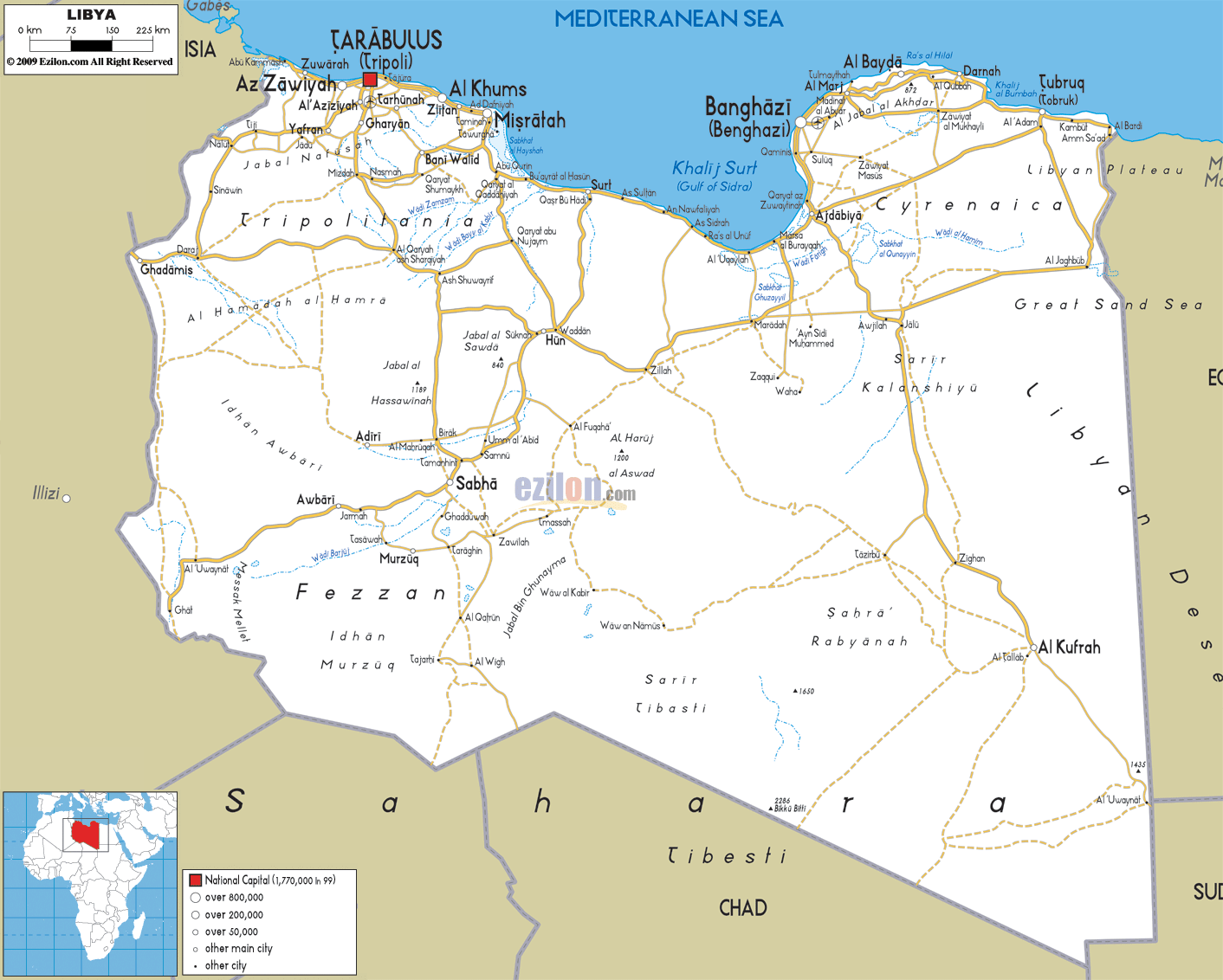With an area of almost 1.8 million square kilometres (700,000 sq mi), Libya is the fourth largest country in Africa by area, and the 17th largest in the world. The largest city, Tripoli, is home to 1.7 million of Libya's 6.4 million people. The three traditional parts of the country are Tripolitania, Fezzan, and Cyrenaica.
As a result of the civil war of February to October 2011 and the collapse of the Gaddafi regime which had been in power for more than 40 years, Libya is currently administrated by a caretaker government, known as the National Transitional Council.
The name Libya (i/ˈlɪbiə/ or /ˈlɪbjə/; Arabic: ليبيا Līb(i)yā [ˈliːbⁱjaː] ( listen); Libyan Arabic: [ˈliːbjæ] ( listen)) was introduced in 1934 for Italian Libya, after the historical name for Northwest Africa, from Greek Λιβύη (Libúē).
Italian Libya united the provinces of Tripolitania, Cyrenaica (Barca) and Fezzan under the name, based on earlier use in 1903 by Italian geographer Federico Minutilli, and by the Italian government in its "Regio Decreto di Annessione" (Royal Decree of Annexation) of the Ottoman provinces of Tripolitania and Cyrenaica dating November 5, 1911.
Libya gained independence in 1951 as the United Libyan Kingdom (Arabic: المملكة الليبية المتحدة al-Mamlakah al-Lībiyyah al-Muttaḥidah), changing its name to the Kingdom of Libya (Arabic: المملكة الليبية al-Mamlakah al-Lībiyyah) in 1963. Following a coup d'état in 1969, the name of the state was changed to the Libyan Arab Republic (Arabic: الجمهورية العربية الليبية al-Jumhūriyyah al-'Arabiyyah al-Lībiyyah).
From 1977 to 2011, Libya was known as the "Libyan Arab Jamahiriya" at the United Nations. The official name during this period was "Socialist People's Libyan Arab Jamahiriya" from 1977 to 1986, and "Great Socialist People's Libyan Arab Jamahiriya" (Arabic: الجماهيرية العربية الليبية الشعبية الاشتراكية العظمى al-Jamāhīriyyah al-'Arabiyyah al-Lībiyyah ash-Sha'biyyah al-Ishtirākiyyah al-'Uẓmá listen (help·info)) from 1986 to 2011.
The National Transitional Council, established in 2011, refers to the state as simply "Libya", but there is some evidence that in the beginning they also used the term "Libyan Republic" (Arabic: الجمهورية الليبية al-Jumhūriyyah al-Lībiyyah). In late August 2011, Bosnia and Herzegovina used the term in its formal recognition of the NTC. Tens of thousands of years ago, the Sahara desert, which now covers roughly 90% of Libya, was lush with green vegetation. It was home to lakes, forests, diverse wildlife and a temperate Mediterranean climate. Archaeological evidence indicates that the coastal plain of Ancient Libya was inhabited by Neolithic peoples from as early as 8000 BC. These peoples were perhaps drawn by the climate, which enabled their culture to grow; the Ancient Libyans were skilled in the domestication of cattle and the cultivation of crops. Rock paintings and carvings at Wadi Mathendous and the mountainous region of Jebel Acacus are the best sources of information about prehistoric Libya, and the pastoralist culture that settled there. The paintings reveal that the Libyan Sahara contained rivers, grassy plateaus and an abundance of wildlife such as giraffes, elephants and crocodiles.
As a result of the civil war of February to October 2011 and the collapse of the Gaddafi regime which had been in power for more than 40 years, Libya is currently administrated by a caretaker government, known as the National Transitional Council.
The name Libya (i/ˈlɪbiə/ or /ˈlɪbjə/; Arabic: ليبيا Līb(i)yā [ˈliːbⁱjaː] ( listen); Libyan Arabic: [ˈliːbjæ] ( listen)) was introduced in 1934 for Italian Libya, after the historical name for Northwest Africa, from Greek Λιβύη (Libúē).
 map of Sirte basin |  on the situation in Libya, |  LIBYA Map SIRTE BASIN |  LIBYA Map SIRTE BASIN |  Libya |
 Map of the Site, |  Sirte is located between the |  sirte map; sirte; sirte libya |  Libya produces 2.1% of the |  SIRTE, Libya -- With NATO jets |
From 1977 to 2011, Libya was known as the "Libyan Arab Jamahiriya" at the United Nations. The official name during this period was "Socialist People's Libyan Arab Jamahiriya" from 1977 to 1986, and "Great Socialist People's Libyan Arab Jamahiriya" (Arabic: الجماهيرية العربية الليبية الشعبية الاشتراكية العظمى al-Jamāhīriyyah al-'Arabiyyah al-Lībiyyah ash-Sha'biyyah al-Ishtirākiyyah al-'Uẓmá listen (help·info)) from 1986 to 2011.
 Map locates Sirte, Libya. |  #Libya map Sirte Frontlines |  Gulf of Sirte, Libya map zoom x 20 |  map of cities in Libya |  Tripoli and Sirte are |
 Sirte Map |  This map, from Iyad |  #Libya: Map #Sirte Libyan |  Sirte, hometown of Libyan |  #Libya: Map #Sirte Libyan |
No comments:
Post a Comment